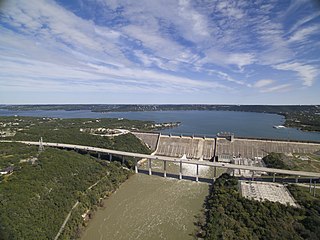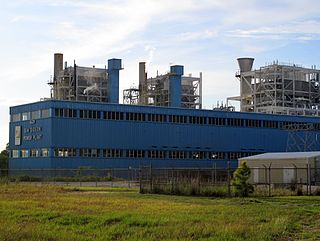
The Lower Colorado River Authority (LCRA) is a nonprofit public utility created in November 1934 by the Texas Legislature. LCRA's mission is to enhance the lives of the Texans it serves through water stewardship, energy and community service. LCRA provides public power, manages the lower Colorado River, builds and operates transmission lines, owns public parks, and offers community services.

Lake Travis is a reservoir on the Colorado River in central Texas in the United States.

Mansfield Dam is a dam located across a canyon at Marshall Ford on the Colorado River, 13 miles (21 km) northwest of Austin, Texas. The groundbreaking ceremony occurred on February 19, 1937, with United States Secretary of the Interior Harold L. Ickes attending. The dam was a joint project by the Lower Colorado River Authority (LCRA) and the United States Bureau of Reclamation, with partial funding provided by the Public Works Administration. Brown and Root, headed by James E. Walters, Sr., was the prime contractor. The dam was completed in 1941. Originally called Marshall Ford Dam, the name was changed in 1941 in honor of United States Representative J.J. Mansfield. The reservoir behind Mansfield Dam is named Lake Travis. The dam is owned and operated by the LCRA.

Hydroelectricity, or hydroelectric power, is electricity produced from hydropower. In 2015, hydropower generated 16.6% of the world's total electricity and 70% of all renewable electricity, and was expected to increase by about 3.1% each year for the next 25 years.

The Sim Gideon Power Plant is a 620 megawatt (MW), natural gas fired power plant located near Bastrop, Texas in Bastrop County, Texas. It is owned and operated by the Lower Colorado River Authority. The Sim Gideon Power Plant consists of three generating units that operate via simple cycle combustion turbine utilizing natural gas. The plant, along with Lost Pines Power Project 1, is part of the Lost Pines Power Park.
The Lost Pines Power Project 1 is a natural gas fired power plant located near Bastrop, Texas in Bastrop County, Texas. It is owned by GenTex Power Corporation, a wholly owned affiliate of the Lower Colorado River Authority. The plant, along with Sim Gideon Power Plant, is part of the Lost Pines Power Park. The plant was completed in 2001, and has a generating capacity of 545 megawatts provided by 2 natural gas fired gas turbines in a combined cycle configuration with one steam turbine.

The Thomas C. Ferguson Power Plant consists of dual natural gas fired turbines and a single steam turbine run by exhaust heat from the gas turbines in a combined cycle configuration that generates 540 megawatts (MW) of electricity. The facility is located near Horseshoe Bay in Llano County, Texas, United States. It is owned and operated by the Lower Colorado River Authority (LCRA) and was named for Thomas C. Ferguson, a member of LCRA's first Board of Directors. Cooling water is provided by Lake LBJ, a freshwater reservoir created by Wirtz Dam.

WEC Energy Group is an American company based in Milwaukee, Wisconsin that provides electricity and natural gas to 4.4 million customers across four states.

Cochrane Dam is a minor earthfill embankment dam with concrete spillway across Georges Creek, located in the South Coast region of New South Wales, Australia. The main purpose of the dam is to supply water for hydro-power at the downstream Brown Mountain Power Station and for irrigation purposes. The impounded reservoir is called Cochrane Lake.

Run-of-river hydroelectricity (ROR) or run-of-the-river hydroelectricity is a type of hydroelectric generation plant whereby little or no water storage is provided. Run-of-the-river power plants may have no water storage at all or a limited amount of storage, in which case the storage reservoir is referred to as pondage. A plant without pondage is subject to seasonal river flows, thus the plant will operate as an intermittent energy source. Conventional hydro uses reservoirs, which regulate water for flood control, dispatchable electrical power, and the provision of fresh water for agriculture.

Bull Run Fossil Plant, commonly known as Bull Run Steam Plant, is a 889 megawatt (MW), coal-fired electric generating station owned and operated by the Tennessee Valley Authority (TVA). The plant is the only coal fired power plant ever constructed by TVA with one unit, and is expected to close in 2023.

The Colorado River Storage Project is a United States Bureau of Reclamation project designed to oversee the development of the upper Colorado River basin. The project provides hydroelectric power, flood control and water storage for participating states along the upper portion of the Colorado River and its major tributaries.
According to the International Hydropower Association, Canada is the world's fourth largest producer of hydroelectricity in the world in 2020 after the United States, Brazil, and China. In 2014, Canada consumed the equivalent of 85.7 megatonnes worth of oil of hydroelectricity, 9.8% of worldwide hydroelectric consumption. Furthermore, hydroelectricity accounted for 25.7% of Canada's total energy consumption. It is the third-most consumed energy in Canada behind oil and natural gas.

The Dix Dam is a dam on the Dix River located between Mercer and Garrard County, Kentucky. It was constructed to generate hydroelectricity and prevent flooding of the Kentucky River but is better known for creating Herrington Lake.
The R. Gallagher Generating Station was a four-unit coal-burning power plant located along the Ohio River some two miles (3 km) downstream from New Albany, Indiana in southernmost Floyd County, Indiana. The total aggregate capacity (year-around) of the plant's four identical units was 560MW. Unit 2 began operating in 1958; unit 1 in 1959; unit 3 in 1960 and unit 4 in 1961. In early 2012, both Units 1 and 3 were retired. Units 2 and 4 continued to operate because Duke Energy installed baghouses, greatly reducing the pollution and meeting the current standards set by the EPA. The plant's 2012 output was 280 megawatts. The plant is connected to the grid by 138 and 230 kilovolt transmission lines.
AES Andes S.A., formerly AES Gener S.A., is a producer and distributor of electricity based in Santiago, Chile, which operates in South America's Andes region.
The Salina Pumped Storage Project is a 260-megawatt (350,000 hp) pumped-storage power station near Salina, Oklahoma. It is owned and operated by the Grand River Dam Authority (GRDA). Its construction was in response to growing power demands and a lack of dam sites on the Grand River. The first phase was completed in 1968 and the second in 1971. The upper reservoir for the power station is Lake W. R. Holway which was built on Saline Creek and the lower reservoir is Lake Hudson on the Grand River. During periods of lower power demand, water is pumped from Lake Hudson to Lake Holway and released back down through the pump-generators during periods of high energy demand.

The Vianden Pumped Storage Plant is located just north of Vianden in Diekirch District, Luxembourg. The power plant uses the pumped-storage hydroelectric method to generate electricity and serves as a peaking power plant. Its lower reservoir is located on the Our River, bordering Germany, and the upper is elevated above on the nearby Saint Nicholas Mountain. Construction on the plant began in 1959 and the first pump-generators were commissioned in 1962. A tenth pump-generator was installed in 1976 bringing the plant's installed generating capacity to 1,096 megawatts (1,470,000 hp). The plant generates an average of 1,650 gigawatt-hours (5,900 TJ) annually but of course consumes even more. Generally the efficiency of this energy storage method is around 70-80%. The plant is owned by Société électrique de l'Our and RWE. Construction on an eleventh pump-generator began in 2010 and it is expected to be commissioned in 2013, which will bring the plant's installed capacity to 1,296 megawatts (1,738,000 hp).















